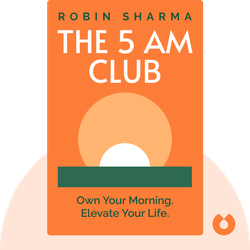Try Blinkist to get the key ideas from 7,000+ bestselling nonfiction titles and podcasts. Listen or read in just 15 minutes.
Start your free trial
Blink 3 of 8 - The 5 AM Club
by Robin Sharma

How to Rebuild Brand Authenticity in a Distrusting World
'The Post-Truth Business' by Sean Pillot de Chenecey explores the increasing trend of companies using emotional manipulation, disinformation and fake news to connect with consumers in a world where objective truth is less influential.
Stable societies are unthinkable without people accepting shared truths. That’s why it’s so important that people can trust the media. If folks don’t believe that the facts gathered and reported by newspapers and other outlets are true, they’re unlikely to ever compromise, let alone agree with their fellow citizens. This system of generating commonly accepted truths has, however, broken down.
Call it the post-truth era. That’s shorthand for today’s chaotic media environment, where truths are manipulated and misinformation has become a growth business. So what went wrong and how did we end up here?
The term “post-truth” goes back to an essay published in the early 1990s by the playwright Steve Tesich. He wrote the essay in response to the revelation that the US government had been illegally selling arms to Iran to fund an anti-government guerilla group in Nicaragua known as the Contras.
This was something President Ronald Reagan had strenuously denied. Remarkably, Reagan’s supporters continued to defend him even after the truth came out. Why was that? Well, emotions had trumped facts. Reagan stated that his heart had told him the accusations were false, and this was good enough for many Americans.
Others, meanwhile, lost all faith in government. It was the first sign that citizens no longer agreed on basic empirical truths, and as citizens began searching for “alternative facts” that fit their personal narratives, trust in the mainstream media plummeted too. According to Gallup survey data, 72 percent of Americans trusted the media in 1976; by 2016, that number had fallen to just 32 percent.
This trend was amplified by the arrival of the internet. As a 2018 Rand Corporation report points out, so-called “truth decay” now affects countries around the world. From the US to Germany, Turkey and India, members of the same societies increasingly believe in radically-opposed accounts of reality.
This is largely because posts on social media, unlike real journalism, are easy and cheap to produce and are rarely – if ever – fact-checked. The results have been a torrent of fake accounts pushing partisan, divisive propaganda disguised as news items, which we've come to know as “fake news.” In 2018 alone, Facebook identified and disabled 520 million fake accounts in just three months!
Add all these factors together and you’re left with extremely fragile societies. As we’ll see in the next blink, this isn’t just a political story – it also affects economic life.



The Post-Truth Business (2018) addresses a question that’s been keeping marketing and advertising agencies up at night for a while now: How do you persuade consumers to trust your brand in an increasingly distrustful world? Drawing on Sean Pillot de Chenecey’s first-hand knowledge of the industry known as “adland,” these blinks show how today’s most innovative companies are strengthening consumer engagement and making sure that their brand doesn’t end up with a credibility gap.
The Post-Truth Business (2018) by Sean Pillot de Chenecey explores the rise of post-truth culture and how it impacts marketing, advertising, and branding. Here's why this book is worth reading:
Without trust, and without an understanding of how it is built, managed, lost and repaired, a society cannot thrive. – Rachel Botsman

It's highly addictive to get core insights on personally relevant topics without repetition or triviality. Added to that the apps ability to suggest kindred interests opens up a foundation of knowledge.
Great app. Good selection of book summaries you can read or listen to while commuting. Instead of scrolling through your social media news feed, this is a much better way to spend your spare time in my opinion.
Life changing. The concept of being able to grasp a book's main point in such a short time truly opens multiple opportunities to grow every area of your life at a faster rate.
Great app. Addicting. Perfect for wait times, morning coffee, evening before bed. Extremely well written, thorough, easy to use.
Try Blinkist to get the key ideas from 7,000+ bestselling nonfiction titles and podcasts. Listen or read in just 15 minutes.
Start your free trial
Blink 3 of 8 - The 5 AM Club
by Robin Sharma
What is the main message of The Post-Truth Business?
The main message of The Post-Truth Business is the impact of lies and misinformation on modern marketing and society.
How long does it take to read The Post-Truth Business?
The reading time for The Post-Truth Business varies depending on the reader, but it typically takes several hours. However, the Blinkist summary can be read in just 15 minutes.
Is The Post-Truth Business a good book? Is it worth reading?
The Post-Truth Business is a crucial read for those interested in understanding the challenges of modern marketing. It provides valuable insights into the post-truth era.
Who is the author of The Post-Truth Business?
The author of The Post-Truth Business is Sean Pillot de Chenecey.